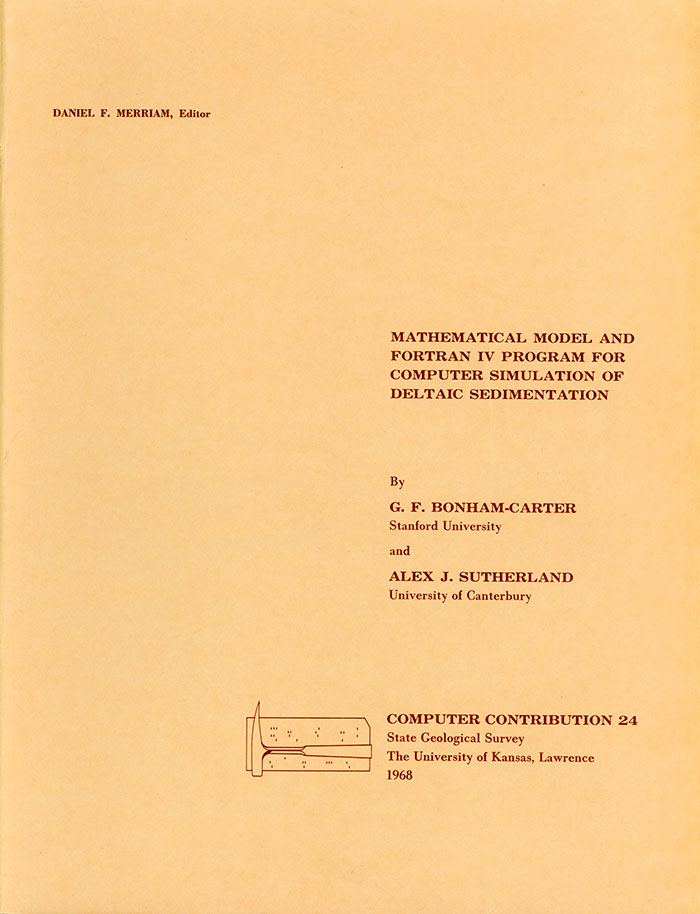
Kansas Geological Survey, Computer Contributions 24, originally published in 1968
1Stanford University and 2University of Canterbury

Originally published in 1968 as Kansas Geological Survey Computer Contributions 24.
DELTASIM is a FORTRAN IV program for simulating deltaic sedimentation at a single river-channel mouth. A sediment-laden river flowing into a tideless, currentless marine basin is modeled as a plane jet discharging horizontally at the ocean surface. A velocity field is calculated using equations for open-channel and plane-jet flow. Sediment behavior is treated statistically; nominal sediment particles are traced along trajectories from the mouth as they spread laterally and settle vertically. The rate of sediment accumulation is calculated for each cell of a horizontal accounting grid. Input parameters include channel dimensions, water and sediment discharge, grain-size distribution and bottom topography. Experiments with a static simulation model illustrate the depositional variation produced by changes in grain size, river depth, and slope. The depositional area is narrow in plan view; in elevation, foreset slopes are a function of grain-size and hydraulic parameters, and are normally less than 10. A dynamic model permits a delta platform to build forward during several time increments, nominal particle trajectories adjusting automatically to the position of the delta lip. Experiments illustrate the formation of bars building transversely across the river mouth and the development of submerged levees close to the mouth at the margins of the main flow.
The computer program runs on an IBM System/360 model 67. Graphic displays in the form of CALCOMP plots form an important part of the program output.
The purpose of this paper is to describe a mathematical model of a simple fluvio-marine delta, to list and discuss a FORTRAN IV program that embodies the mathematical model in a computer simulation framework, and to illustrate the use of the program with sample computer runs.
Computer simulation only recently has been applied by geologists to sedimentation problems. Harbaugh (1966; Harbaugh and Wahlstedt, 1967) developed a generalized marine sedimentation model oriented toward the biological factors in sedimentation. Harbaugh's model is probabilistic in structure and makes extensive use of Markov processes. Briggs and Pollack (1966) simulated the circulation of water and deposition of evaporites in a restricted basin. Their approach was a deterministic one, with basic physical principles being used to determine a velocity field and to calculate brine concentration and thickness of salt deposits. The present delta model also is deterministic in structure. Transport and deposition of suspended sediment at river mouths is modeled by determining a velocity field and allowing sediment issuing from a river mouth to be sorted according to hydraulic principles. Bonham-Carter and Sutherland (1967) gave a preliminary account of the model.
As with the Harbaugh and Briggs-Pollack models, a grid mesh is used to subdivide the area into a number of discrete cells. Each cell is treated as a separate unit and contains values of attributes such as water depth and sediment thickness. The grid technique is useful for allowing complex surfaces to be described closely by an array of numbers stored in the computer. Most analytical mathematical models are unable to represent complex surfaces, and are restricted to those surfaces that may be described by polynomial or trigonometric functions. Furthermore, a cellular gridwork, coupled with the necessary programming steps, may be used as a massive bookkeeping device. Each cell has inputs and outputs for the materials in the system and all transactions must be recorded. Finally, the gridded nature of the stored information is in an ideal form for graphic display of maps and cross sections, using either the line printer or digital plotting devices. Graphic display is important for displaying geometric relationships that are difficult to describe mathematically, and for bringing the model to 'life' by illustrating it in an easily interpreted form. A map conveys information much more effectively than a table.
This model considers the hydraulic aspects of sediment deposition at river mouths, and thus is approaching the delta problem from the process point of view. Rather than starting with field data regarding the form and composition of a delta, from which statistical interrelationships are derived and inferences drawn regarding the processes, the processes themselves are used as the starting point. By formulating a model about the processes, simulation experiments are used to determine the composition and form of a 'delta' with different initial assumptions. This approach thus focuses strongly on the processes themselves.
Although the model does not have an immediate application to most real deltas, because few if any deltas are formed without modification by offshore energy factors, it does afford the geologist a technique to explore the interrelationships between the variables important in the constructive phase of delta building. This is an essential step in the development of more sophisticated and complex models. Sediments deposited in deltas comprise an important part of the sedimentary rock record, both quantitatively and economically, and may form stratigraphic traps for oil. Further insight into the formation of deltas is important to geology, and computer simulation is a technique that should be fruitful, particularly when executed in combination with field observations and flume experiments.
We thank J.W. Harbaugh, R.L. Street, and C. Sonu for critically reading an early version of this manuscript. The work was supported by the Office of Naval Research under contract number N00014-67-A-0112-004 Task number NR 388-081. Reproduction is permitted for any purposes of the United States Government.
Read the PDF version (12 MB)
Kansas Geological Survey
Placed on web Sept. 6, 2019; originally published 1968.
Comments to webadmin@kgs.ku.edu
The URL for this page is http://www.kgs.ku.edu/Publications/Bulletins/CC/24/index.html